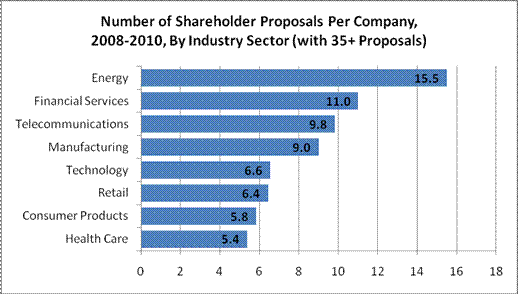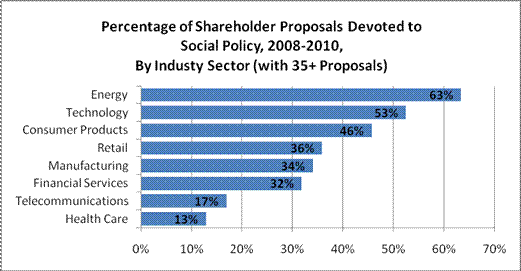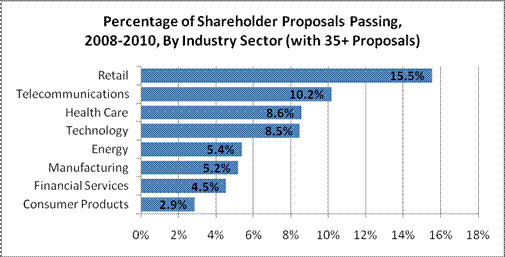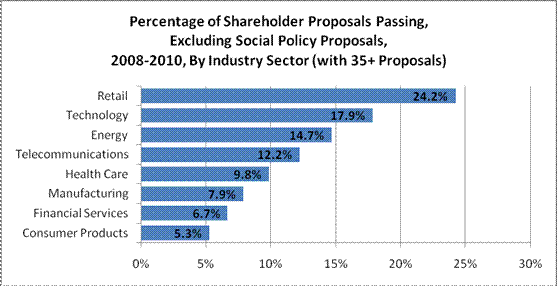Manhattan Institute Proxy Monitor Finding 4
Industry-by-Industry Trends
Shareholder Proposal Activity and Success Vary By Sector
Retail, Technology Firms Most Susceptible to Shareholder Activism; Unions Target Retail and Financials
The
Manhattan Institute’s first three Proxy Monitor “findings”—analyses drawn from
information in the Institute’s ProxyMonitor.org database of shareholder
proposals submitted to Fortune 100 companies between 2008 and 2010—looked at how
proposal activity varied by type (corporate governance, executive compensation,
and social policy).[1] This finding looks at how proposal activity has varied by industrial sector, specifically asking:
a) Which industries have been most likely to be the targets of shareholder proposals?
- How does the composition of such proposals vary?
- Which industries have been most likely to be targeted by labor-union pension funds?
b) Which industries have been most likely to see shareholder proposals approved?
a) Which industries have been most likely to be the targets of shareholder proposals?
The Manhattan Institute’s preliminary report released with the launch of the ProxyMonitor.org database observed that oil companies ExxonMobil and ConocoPhillips, as well as banking giants Citigroup, JPMorgan Chase, and Bank of America, were the five most frequent corporate targets of shareholder proposals between 2008 and 2010.[2] The report concluded “that energy and financial companies are more likely to be the targets of shareholder activists.”[3]
Further analysis across all companies classified by industrial sector confirms these initial conclusions: energy and financial companies were targeted by a greater number of shareholder proposals than were firms in any other sector from 2008 to 2010 (see graph). The average energy company has been targeted by 15.5 shareholder proposals over that time, and the average financial company by 11.0. The least-targeted sectors were consumer products and health care, with 5.8 and 5.4 proposals per company over the period.[4]

To some degree, the targeting of energy and financial companies is a function of their size, as the companies drawing the most attention in these sectors are among the largest in the Fortune 100. To test additional hypotheses that might explain sector-by-sector variation, the Manhattan Institute examined the degree to which shareholder-proposal type varied by sector, as well as the degree to which shareholder proposals submitted to different sectors had different types of sponsors.
1) How does the composition of such proposals vary?
Because a plurality of all shareholder proposals involve “social policy” questions such as environmental concerns, human rights, and corporations’ political activities, and because some industries might be more sensitive to such concerns than others, the Manhattan Institute looked at how the percentage of shareholder-proposals related to social policy varied by sector. As shown in the graph below, some sectors proved much more likely to attract social-policy shareholder proposals than others.

Relative to other sectors, companies in the energy sector attract a high number of shareholder proposals. The majority of these are social-policy proposals—in particular environment-related proposals. Controlling for social-policy proposals, the energy sector has only the fourth-highest number of shareholder proposals submitted per company. Similarly, companies in the health-care sector are the least-likely targets of shareholder proposals overall in no small part because they are the least likely to be targeted over social policy.
In contrast, while the financial-services companies attract a relatively high number of shareholder proposals, fewer than one-third of these involve social policy. The high number of shareholder proposals submitted to financial companies appears related to other factors—including perhaps the financial-market implosion and subsequent government bailouts, as well as the tendency of labor unions to sponsor proposals for this sector, as explained below.
2) Which industries are most likely to be targeted by labor-union pension funds?
The Manhattan Institute’s Proxy Monitor analyses have consistently noted the significant role played by labor-union pension funds in shareholder activism.[5] Deconstructing unions’ sponsorship of shareholder proposals by industry sector both helps to explain sectoral variation in shareholder-proposal activity and sheds further light on unions’ objectives.

As shown in the graph, labor-union pension funds have been far more likely to submit shareholder proposals to companies in service-oriented fields (retail, telecommunications, and financial services) than in heavy industry or manufacturing fields (consumer-product manufacturing, industrial/general manufacturing, and energy). Such results are striking in that in general the latter fields are more likely to be unionized than the former: 8.8 and 11.6 percent of Americans employed in oil and gas extraction and manufacturing, respectively, are represented by unions, as compared to only 5.6 percent in retail trade and 2.5 percent in the financial sector.[6] Union funds’ decision to target companies in these lightly unionized sectors with shareholder proposals may reflect a desire to extract concessions from management rather than to maximize share value, as critics of union-fund shareholder activism have charged,[7] particularly in light of well-publicized recent efforts to organize these very sectors.[8]
b) Which industries have been most likely to see shareholder proposals approved?
Although energy and financial companies have received the most shareholder proposals, the proposals submitted to companies in these sectors have been relatively unlikely to pass, with only 5.4 percent and 4.5 percent approval rates in the energy and finance sectors, respectively. In contrast, companies in the retail sector have been mostly likely to see such proposals approved by shareholders, with 15.5 percent passage rates.

At least for the energy sector, however, such low passage rates are at least partly explained by the sector’s high percentage of social-policy proposals—none of which has passed during the time examined. Controlling for social-policy proposals reveals that 14.7 percent of energy-sector shareholder proposals were approved, the third-highest pass-rate in the database.
 The retail sector remains the most-likely sector for shareholder-proposal approval even after controlling for social-policy proposals, followed by the technology sector. The retail companies for which one or more shareholder proposals were approved include McDonald’s, Macy’s, Home Depot, Staples, Walgreen, CVS Caremark, Kroger, and Safeway. Successful proposals in the retail sector include proposals to require simple-majority voting standards and to allow shareholders to vote by written consent or call special meetings, as well as executive-compensation-related proposals. Successful sponsors of proposals to this sector included union funds and individual shareholder activists John Chevedden, William and Kenneth Steiner, and Nick Rossi.
The retail sector remains the most-likely sector for shareholder-proposal approval even after controlling for social-policy proposals, followed by the technology sector. The retail companies for which one or more shareholder proposals were approved include McDonald’s, Macy’s, Home Depot, Staples, Walgreen, CVS Caremark, Kroger, and Safeway. Successful proposals in the retail sector include proposals to require simple-majority voting standards and to allow shareholders to vote by written consent or call special meetings, as well as executive-compensation-related proposals. Successful sponsors of proposals to this sector included union funds and individual shareholder activists John Chevedden, William and Kenneth Steiner, and Nick Rossi.
This report analyzes information gathered from the Manhattan Institute’s ProxyMonitor.org database, which contains information relating to all shareholder proposals submitted for shareholder vote between 2008 and 2010, for the 100 largest American public companies.
ENDNOTES
- SeeManhattan Institute Proxy Monitor Findings 1, 2 & 3 (2011), available at http://www.proxymonitor.org/Forms/Findings.aspx.
- See Manhattan Institute Proxy Monitor Report (Winter 2011), available at http://www.proxymonitor.org/Forms/Reports.aspx.
- Id.
- The analysis excluded those sectors with fewer than six companies.
- See Manhattan Institute Proxy Monitor Report (Winter 2011), available at http://www.proxymonitor.org/Forms/Reports.aspx; See Manhattan Institute Proxy Monitor Findings 1, 2 & 3 (2011), available at http://www.proxymonitor.org/Forms/Findings.aspx.
- See Bureau of Labor Statistics, Union affiliation of employed wage and salary workers by occupation and industry (2010), http://www.bls.gov/news.release/union2.t03.htm.
- See, e.g., Stephen M. Bainbridge, Shareholder Activism in the Obama Era, UCLA School of Law, Law-Econ Research Paper No. 09-14, July 22, 2009, available at http://papers.ssrn.com/sol3/papers.cfm?abstract_id=1437791; Stephen Bainbridge, Unions Abusing Pension Funds for Politics, Wash. Examiner, Sept. 6, 2007, available at http://washingtonexaminer.com/node/421936; see also Manhattan Institute for Policy Research, Trial Lawyers, Inc.: California 12-13(2005), available at http://www.triallawyersinc.com/ca/ca06.html.
- See, e.g., Press Release, United Food and Commercial Workers International Union, Raising Wages and Benefits for Retail Workers, Oct. 8, 2009, available at http://www.groceryworkersunited.org/PR_100809_Raising_Wages.shtml; Mike Elk, Too Big Not to Organize: SEIU-International Coalition Try to Unionize the Banks, Huffington Post, July 29, 2010, available at http://www.huffingtonpost.com/mike-elk/too-big-not-to-organize_b_663940.html.